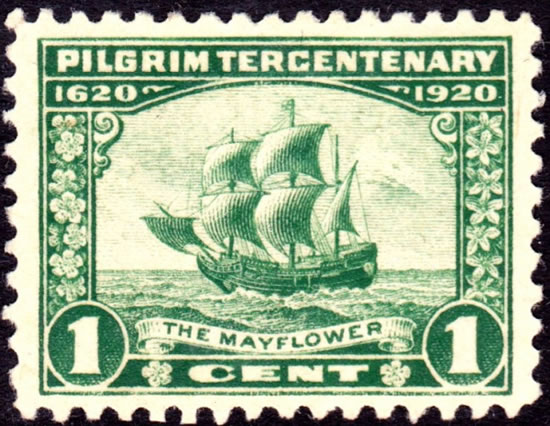The Mayflower ship is most widely known for transporting the Pilgrims, also known as the first English Separatists, from England to the New World in 1620. The story of this voyage is well known from the very beginning of American history, as the first Americans traveled across the vast Atlantic Ocean, enduring a lengthy and miserable journey, only to struggle to survive their first harsh New England winter. It is a story that includes tragic loss, death, and the resounding struggle to survive.
In 1620, the Mayflower was considered an older ship nearing the end of an average ship’s lifespan of about 15 years. Its design included a thirty foot high square castle-like structure which made it difficult to sail against the North Atlantic’s prevalent fall and winter winds. These factors contributed to the ship’s lengthy voyage of over two months, twice the length of time it took for the Mayflower to return to London the next spring. This journey was plagued by huge waves battering against the ship’s top deck. During the voyage, an essential support beam broke, requiring passengers to assist the ship’s carpenter as they repaired the main support beam.
While there are no details stating the exact dimensions of the hull, the three-mast Mayflower is estimated to have measured 100 feet long and 25 feet wide at her widest point and had three primary levels: the main deck, the gun deck, and the cargo hold. The Mayflower carried a cargo of 180 tons, and records indicate she could easily hold 180 casks (large barrels that held hundreds of gallons) of wine in the cargo hold.
In anticipation of encountering pirates, the Mayflower, like most other ships traveling on trade routes around Europe, prepared by heavily arming herself with powder and ammunition for guns, cannons, and other weapons. Among her many cannons, the largest gun was a minion cannon made of brass, weighing about 1,200 pounds. This cannon could shoot a 3.5 pound cannonball almost a mile away. The Mayflower carried multiple other cannons as well, four of which were unloaded upon docking in the New World to help strengthen the new colony against invaders.
The Mayflower carried supplies for the Pilgrims to begin their future lives including weapons and ammunition and live animals such as dogs, sheep, goats, and poultry. She also transported two smaller boats powered by oars or smaller sails, and twelve artillery pieces in case the Pilgrims needed to defend against the Natives of the New World.
Only two passengers aboard the Mayflower died during the journey, foreshadowing the more grim reality that approximately half of the original settlers would not survive their first Massachusetts winter. |

